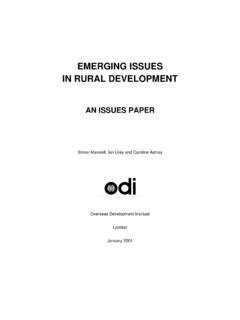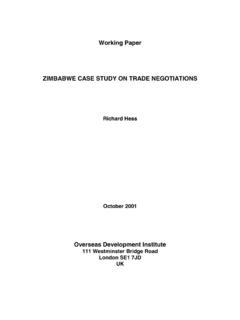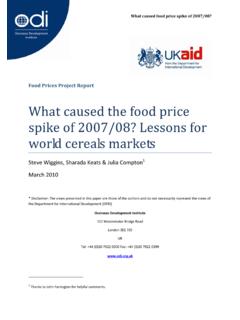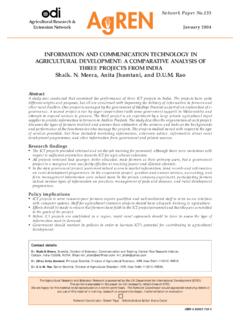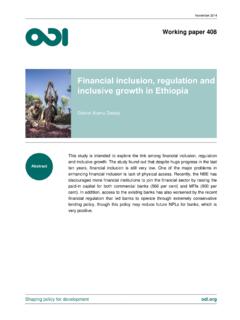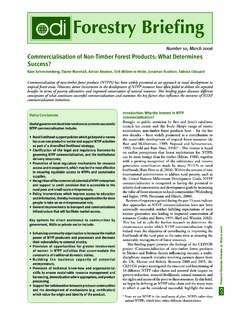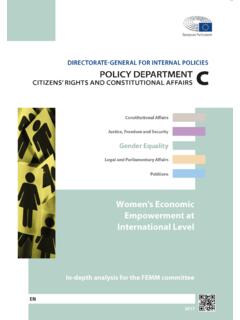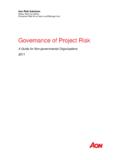Transcription of Good Enough Governance Redux
1 good Enough Governance Revisited A Report for DFID with reference to the Governance Target Strategy Paper, 2001 Merilee S. Grindle Harvard University February 2005 That good Governance matters for development and the capacity to address difficult issues of poverty reduction has become a mantra for development professionals. While many are pleased to see development debates move beyond an earlier approach that promised development when poor countries get the policies right, the adoption of the good Governance paradigm implies a very wide range of institutional preconditions for economic and political development and for poverty to be significantly reduced. Getting good Governance calls for improvements that touch virtually all aspects of the public sector from institutions that set the rules of the game for economic and political interaction, to decision-making structures that determine priorities among public problems and allocate resources to respond to them, to organizations that manage administrative systems and deliver goods and services to citizens, to human resources that staff government bureaucracies, to the interface of officials and citizens in political and bureaucratic surprisingly, advocating good Governance raises a host of questions about what needs to be done, when it needs to be done, and how it needs to be Recently.
2 The idea of good Enough Governance questioned the length of the good Governance agenda and its essentialist This concept suggested that not all Governance deficits need to be (or can be) tackled at once and that institution and capacity building are products of time; Governance achievements can also be reversed. good Enough Governance means that interventions thought to contribute to the ends of economic and political development need to be questioned, prioritized, and made relevant to the conditions of individual countries. They need to be assessed in light of historical evidence, sequence, and timing, and they should be selected carefully in terms of their contributions to particular ends such as poverty reduction and democracy. good Enough Governance directs attention to considerations of the minimal conditions of Governance necessary to allow political and economic development to Thus, the concept of good Enough Governance has provided a platform for questioning the long menu of institutional changes and public capacity building initiatives that are currently deemed important (or essential) for development.
3 Still, it falls short of being a tool to explore what, specifically, needs to be done in any real world context. The gap between a long agenda, general advice on how this agenda might be made more parsimonious, and what is actually chosen as a Governance intervention is particularly noticeable to those who must address the weak, conflict-ridden, and often illegitimate status of fragile states. This paper addresses the gaps that exist between the general mandate to improve Governance for development and poverty reduction and the dilemmas facing development professionals as they design interventions meant to improve Governance in specific contexts. It begins with a review of recent literature about good Governance ; this review indicates that despite a general agreement on the importance of good Governance , there remain a number of unanswered questions about which institutions matter most and which kinds of Governance interventions are most likely to promote development in individual countries and regions.
4 Moreover, while current scholarship makes important contributions to debates about good Governance , it does not effectively respond to the central question that practitioners must address: Given limited resources of money, time, knowledge, and human and organizational capacities, what are the best ways to move toward better Governance in a particular country context? In the second section of the paper, I suggest a strategy to bridge the gap between what can be learned from research and decisions that must be made in the real world. I indicate that the utility and feasibility of particular Governance interventions can be assessed by analyzing the context for change in Governance and the implications of the content of the intervention being considered. The context for change directs attention to existing state capacities and asks what is there to build upon?
5 The content of proposed interventions draws attention to the ease or difficulty of undertaking such changes and asks, what is required to move forward with this intervention? The paper includes a framework for assessing both contextual and content related factors at the same time. I. Thinking about good Governance : Dilemmas and Debates Debates about good Governance begin with its definition. Indeed, as the concept has grown in popularity within the development community, the number of ways it has been defined has multiplied. Table 1 presents a sample of recent definitions of Governance from official and scholarly sources, and suggests the complexity of the concept. While there are some commonalities across these definitions Governance deals with institutional process and the rules of the game for authoritative decision making, for example they differ significantly in terms of specificity and Table 1 In moving from the definition of Governance to the definition of good Governance , normative views of what ought to be are much more prominent.
6 Yet definitions vary in the degree to which they imply particular policies or policy outcomes stable macroeconomic policy, reduction in poverty, openness to trade, decentralization, or efficient revenue collection, for example or particular institutional forms democracy, widespread participation in 2development decision-making, or strong legislatures, for Moreover, given such broad definitions, it is often not clear how Governance can be distinguished from development itself. Beyond concerns about definitions of Governance and good Governance is a contentious debate about measurement, indicators, and inference. Such debates are important because they are predicated on questions about how characteristics such as rule of law, transparency, or accountability can be operationalized and compared across countries or within countries at different moments in time in ways that are They deal also with concerns about cause and effect relationships do particular conditions of good Governance lead to development or are they a consequence of it?
7 Researchers working on these problematic issues often differ in approach and are at times highly critical of the work of others. Yet they tend to agree that although the measurement of good Governance is problematic and inexact, it is worth the effort to attempt such work in order to clarify thinking and to set a basis for cross-national and longitudinal comparisons. Problems of definition, measurement, and inference are apparent in at least two strands of recent development thinking. The first and perhaps most influential strand uses large cross-country statistical analyses to ask a high order question: What is the relationship between good Governance on the one hand, and economic and political development on the other? A second strand uses country case studies and focused comparisons among a limited number of countries to explore what can be learned from their Governance and development histories.
8 Methodological choices about how to study the issue of Governance and development have considerable impact on findings large N studies tend to find consistent correlations between development and good Governance , while small N studies tend to demonstrate that development is not fully dependent on getting Governance right. Large N Cross-National Research. Considerable attention in recent development literature has been applied to an important question: What is the relationship between good Governance and development? Most such analyses rely heavily on cross-national rather than longitudinal data; countries at different levels of development substitute for the history of Governance and development conditions experienced by the countries in the sample. In general, regression analyses of cross-country data indicate significant correlations between characteristics of good Governance and level of economic development.
9 As examples of this literature, cross-country regression analysis has confirmed the following high order generalizations: Institutional development contributes to growth and growth contributes to institutional Institutional efficiency reduces Weberian characteristics of public bureaucracies are strongly associated with Growth and investment are increased in the presence of institutions to protect property Government credibility contributes to investment and Aid assists growth in contexts in which there is good economic Unstable political contexts are associated with lower levels of Corruption is associated with ineffective government and low Fiscal decentralization is positively correlated with good 3 In addition, researchers have become interested in using statistical techniques to tease out cause and effect relationships.
10 The work of Daniel Kaufmann and others on the impact of corruption on growth, for example, has been important in arguing that the relationship between Governance and development is more than correlational, it is causal good Governance makes development This strand in the research is notable for lively methodological debates about issues of measurement and inference. It is also a literature that is frequently cited to argue for the importance of Governance interventions as preconditions for development. Thus, for example, a World Bank review of 40 different studies concluded that there is overwhelming evidence that good Governance is crucial for successful development, as measured by high per capita income. Per capita income is a strong predictor of poverty rates, infant mortality and illiteracy, suggesting that good Governance improves the well-being of the poor.
